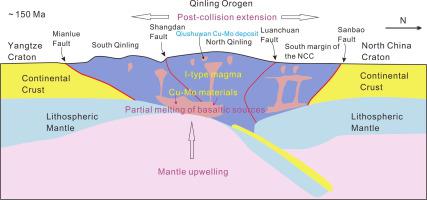Ore Geology Reviews ( IF 3.2 ) Pub Date : 2021-01-19 , DOI: 10.1016/j.oregeorev.2021.103998 Qingquan Liu , Huan Li , Yongjun Shao , Musa Bala Girei , Weicheng Jiang , Haiming Yuan , Xu Zhang

|
The Qiushuwan Cu–Mo deposit, closely associated with porphyritic granodiorites, form part of the giant East Qinling Mo belt. To better constrain the genesis, timing and tectonic setting of this world-class Cu–Mo deposit, we present a combined study of whole-rock elemental and Sr–Nd isotopes, zircon U–Pb–Hf isotopes and molybdenite Re–Os systematic of the Qiushuwan deposit. The porphyritic granodiorites associated with the deposit are metaluminous, high-K calc-alkaline granitoids and possess high Sr/Y, La/Yb and characteristic REE patterns devoid of Eu anomalies, displaying typical features of adakitic rocks. Moreover, the rocks yielded moderate negative whole-rock εNd(t) (–7.8 to –7.5), variable zircon εHf(t) (–5 to +0.8) and low (87Sr/86Sr)i ratios (0.705728–0.706617), indicating that the mineralizing magma for the Qiushuwan deposit was largely derived from metasomatized mantle with minor contribution from crustal material. An integrated zircon U–Pb and molybdenite Re–Os dating constrain the magmatic-metallogenic event related to the formation of the Cu–Mo deposit at ∼150 Ma, corresponding to the late Jurassic. In addition, geochemical discrimination plots place the Qiushuwan granodiorite within the field of I-type granitoid, probably emplaced in a post-collisional setting. The post-collision setting provided favorable condition for mantle upwelling, partial melting and magma generation from the lithospheric mantle with minor contribution from the lower crust. It is likely that the lithospheric mantle, metasomatized during the preceding subduction, was hydrous, rich in Cu–Mo materials and had high oxygen fugacity, which collectively favored the formation of large Cu–Mo deposits in the Qinling belt.











































 京公网安备 11010802027423号
京公网安备 11010802027423号